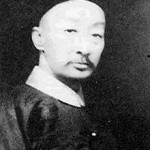
The Hundred Days of Reform was an attempt to modernise China by reforming its government, economy and society. These reforms were launched by the young Guangxu emperor and his followers in June 1898. The need for urgent reforms in China followed the failure of the Self Strengthening Movement and defeat in the Sino-Japanese War of 1894-95. Some intellectuals believed that for significant reform to succeed, it had to come from above. They hoped the young Qing emperor might follow the example of the reform-minded Meiji emperor, who had overseen and encouraged successful economic and military reforms in Japan. But the Hundred Days of Reform was short lived and mostly ineffective, thwarted by the actions of Dowager Empress Cixi and a cohort of conservatives in the Qing government and military. The failure of these reforms is considered a significant starting point for the Chinese Revolution.
The Guangxu Emperor (1871-1908) came to the throne as a four-year-old in 1875, at the height of the Self Strengthening Movement. During the emperor’s childhood matters of policy were dealt with by his aunt, adoptive mother and regent, the Dowager Empress Cixi. Historical accounts suggest the young Guangxu Emperor was reserved, shy and softly spoken – but he was also intelligent and curious. Though schooled in traditional Confucian values of caution, conservatism and respect for tradition, the young emperor developed a growing interest in the progress of other nations, as well as the fate of his own. Like others of the time, he was concerned that China had been overtaken by Japan, an island nation once considered China’s ‘younger brother’. Foreign imperialism also jeopardised China’s sovereignty and the existence of the Qing government. The Guangxu Emperor came to believe that both his dynasty and his country may not survive without significant reform.

One significant figure who shaped the emperor’s views was a young writer named Kang Youwei. Kang was no radical republican: he was a neo-Confucianist who was loyal to the emperor and the Qing dynasty. But Kang was also acutely aware of the dangers that confronted China. In the 1890s Kang published literature that offered a new interpretation of Confucianism. He suggesting it was not only about conserving the status quo but could also be an agent for progress and reform. Beginning in 1890, Kang submitted several memorials to the Guangxu emperor, urging him to consider political and social reforms. These had little impact until January 1898 when Kang Youwei was admitted to the Forbidden City, apparently at the behest of Weng Tonghe, one of the Guangxu Emperor’s tutors. There is some historiographical debate about whether Kang Youwei changed the emperor’s views or simply reinforced them. Whatever the case, Kang was certainly consulted about reform and invited to submit a package of detailed proposals. Kang’s proposed reforms, submitted to the emperor in May 1898, were quite radical. They called not just for superficial changes but a fundamental constitutional overhaul – including the destruction and replacement of government ministries and bureaucracies. In his May 1898 memorial Kang told the emperor:
“Our present trouble lies in our clinging to old institutions without knowing how to change… Nowadays the court has been undertaking some reforms, but the action of the emperor is obstructed by the ministers, and the recommendations of the able scholars are attacked by old-fashioned bureaucrats. If the charge is not “using barbarian ways to change China” then it is “upsetting the ancestral institutions.” Rumours and scandals are rampant, and people fight each other like fire and water. To reform in this way is as ineffective as attempting a forward march by walking backwards. It will inevitably result in failure. Your Majesty knows that under the present circumstances reforms are imperative and old institutions must be abolished.”
Kang’s proposal went on to detail some specific reforms: the drafting and adoption of a constitution, the creation of a national parliament, a review of the imperial examination system and sweeping changes to provincial government and the bureaucracy. In mid-June 1898, the Guangxu emperor gave an audience where he unveiled dozens of broadly-worded edicts, each ordering the reform of a particular branch of government or policy: from the military to money, from education to trade. Over the following 100 days, the emperor issued even more reform edicts, more than 180 altogether. The English language newspaper The Peking Press gave point-form summaries of these reform edicts as they were handed down. The emperor also summoned ministers, generals and officials to the Forbidden City, to receive his edicts and to discuss how reform might be developed and implemented within their respective departments.
As might be expected, many conservatives viewed these sweeping reforms as rushed, panicked and dangerous. The Guangxu Emperor’s decrees outraged traditionalist Confucian scholars, who considered them impetuous and believed they tried to do too much too soon. The reforms also threatened the position of powerful ministers and bureaucrats and created much work and disruption for others. The response was a widespread but potent campaign of whispers and intrigues against the Guangxu emperor. Much of this talk focused on the likely response of the Dowager Empress. Would she move to quash the emperor’s ambitious reforms and perhaps force his abdication? Or if she chose not to act, would the emperor be replaced by a coup d’etat orchestrated by conservative military leaders?
“Some historians said that if the emperor had implemented his changes one at a time, allowing the reactions to flare up and cool down, rather than bombarding the country with reforms, the history of China might have been different. Russian rulers have always taken the approach that one cannot cross a chasm by small steps, and they have wrenched their country out of medieval obscurity through sweeping reforms. But then they did not have an empress dowager at the helm.”
X. L. Woo, historian
In the end, both things occurred. Within days of the first edicts, Cixi was working to thwart the emperor and his reforms. The Dowager Empress ordered the removal of Weng Tonghe, the emperor’s closest advisor and strongest ally, from the Forbidden City. She ordered the appointment of Ronglu, one of her allies, as war minister and commander of the army protecting Beijing; and recruited the support of Yuan Shikai, another powerful general. Cixi now had the tools to remove the emperor – but like a skilled chess player, she waited, allowing the emperor’s own actions to justify her response. The trigger came in September when the Guangxu emperor appointed two foreigners – one English, one Japanese – to his advisory council. Fearing a Qing government influenced or even controlled by foreigners, conservatives urged Cixi to move. She did so on September 21st, entering the emperor’s residence and ordering he sign a document abdicating state power in her favour. Isolated and opposed by conservative military commanders, the young emperor had little choice but to agree.

Shortly after, Yuan Shikai led troops into the Forbidden City and placed the emperor under house arrest. The gates of Beijing were locked as the army hunted down reformists and their supporters. Dozens were captured and executed or thrown into prison; the more fortunate sought refuge in embassies or escaped to exile. Kang Youwei, who had become the figurehead of the reform movement, managed to evade capture and fled to Japan. He was later sentenced in absentia to the notorious ling chi (‘slow slicing’ or ‘death by a thousand cuts’). Within days of regaining power Cixi repealed most of the emperor’s edicts of June-September, allowing some of his milder or less significant reforms to proceed. The imperial examinations were restored, as were several positions and departments abolished by the emperor’s decrees. Newspapers which had actively supported the reforms were shut down. Scholars and writers were ordered to cease submitting memorials on political matters unless they held a government position that entitled them to do so.

The suppression of the Hundred Days reforms surprised few in China. The Western press, which had given only passing attention to the reforms, seethed with indignation about the emperor’s betrayal. One newspaper in Boston, United States described the restoration of Cixi’s authority as “returning darkness” and “a lapse to barbarism in that country”. Many historians have since echoed this position, suggesting the failure of the reforms was a sign of the Qing regime’s unwillingness and inability to adapt and progress. Others have taken a more nuanced view, arguing the reforms failed because they abandoned gradualism, attempted too much in too narrow a timeframe and were unacceptable for the conservative Qing bureaucracy and military. The Guangxu Emperor’s reforms may have failed at large, however, some were permitted to proceed or were adopted later. Beijing University, formed in an edict of July 3rd, continued and became an important source of revolutionary ideas and activity. Some political and educational reforms annulled by Cixi in 1898 were adopted during the last decade of the regime.
1. The Hundred Days of Reform was an attempt by the Guangxu Emperor and his supporters, particularly the writer Kang Youwei, to force rapid modernisation on Chinese government and society.
2. This urgency for reform followed the failure of the Self Strengthening Movement and China’s 1895 defeat in the First Sino-Japanese War.
3. Between June and September 1898 the Guangxu Emperor issued more than 180 reformist edicts, making sweeping changes in areas including government, the bureaucracy, education and the military.
4. The dimensions and the pace of these reforms angered and threatened conservative ministers, bureaucrats and military officers. Some of them lobbied for action from Dowager Empress Cixi.
5. On September 21st, Cixi acted. Backed by conservative military leaders, she forced the emperor to abdicate all state power in her favour. The emperor was held under house arrest and most of his reforms were either abolished and wound back.
© Alpha History 2018. Content on this page may not be republished or distributed without permission. For more information please refer to our Terms of Use.
This page was written by Glen Kucha and Jennifer Llewellyn. To reference this page, use the following citation:
G. Kucha & J. Llewellyn, “The Hundred Days of Reform“, Alpha History, accessed [today’s date], https://alphahistory.com/chineserevolution/hundred-days-reforms/.
This website uses pinyin romanisations of Chinese words and names. Please refer to this page for more information.
